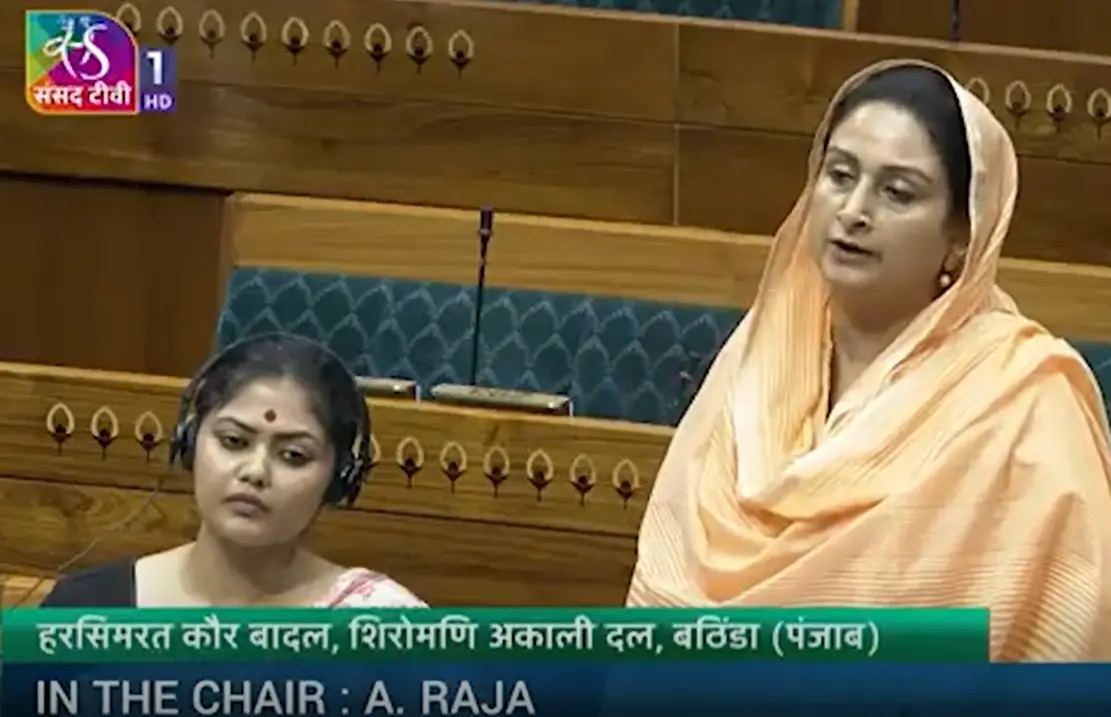
MP Harsimrat Kaur Badal delivered a passionate speech that diverged sharply from the Opposition’s stance
During a special discussion in Parliament on Operation Sindoor, Shiromani Akali Dal (SAD) MP Harsimrat Kaur Badal delivered a passionate speech that diverged sharply from the Opposition’s stance. While many parties criticized the NDA government’s military restraint, Harsimrat defended the decision to end hostilities, citing the suffering of civilians in Punjab and Jammu & Kashmir.
“People spent days and nights in fear, and night after night they lived under the shadow of drone strikes… Farmers of border areas were told to give up on their crops and leave their homes,” she said.
Her remarks were seen not just as a humanitarian appeal but also as a strategic political signal, one that could pave the way for a SAD-BJP rapprochement after years of estrangement. The timing was crucial: Punjab is gearing up for the 2027 Assembly elections, and both parties are recalibrating their strategies.
Back in Punjab, BJP state chief Sunil Jakhar echoed similar sentiments, stating that a reunion between SAD and BJP was necessary to ensure communal harmony. This alignment of narratives has stirred speculation about a possible alliance revival.
The SAD-BJP Split: A History of Fractures and Fallout
The SAD-BJP alliance was once a cornerstone of Punjab politics, ruling the state for a decade under Parkash Singh Badal. However, the partnership unraveled in 2020 over the contentious farm laws introduced by the central government. SAD, which draws its core support from Sikh farmers, found itself at odds with BJP’s agrarian reforms and exited the NDA.
Since then, SAD has struggled to regain its footing, while BJP has attempted to build an independent identity in Punjab. The saffron party has made overtures to the Sikh community through initiatives like the Kartarpur Corridor, Veer Bal Diwas, and academic programs on Sikh history.
Yet, internal divisions persist. BJP’s old guard in Punjab, backed by the RSS, remains skeptical of rejoining SAD. Many believe the party can now win elections independently, citing its 18% vote share in recent parliamentary polls. The ideological mistrust and turf wars from the past still linger.
“The Akalis dictated terms, took the lion’s share of seats and kept the BJP confined to urban pockets,” said a senior BJP leader.
This sentiment reflects a broader resistance within BJP ranks, especially among those who felt marginalized during the previous alliance.
Strategic Calculations: Why a Reunion Is Politically Tempting
Despite the friction, there are compelling reasons for both parties to consider a reunion:
🔹 For SAD:
- Reclaiming lost ground among Sikh voters
- Countering the rise of AAP and Congress in rural Punjab
- Leveraging BJP’s national influence and resources
🔹 For BJP:
- Expanding its footprint in rural and Sikh-majority areas
- Building a broader coalition to challenge AAP’s governance
- Presenting a united front on national security and communal harmony
Harsimrat’s speech may have been a trial balloon, testing public and political reactions to a potential alliance. Her emphasis on peace and civilian welfare resonates with SAD’s traditional base, while aligning with BJP’s nationalistic narrative.
However, the path to reconciliation is riddled with obstacles. SAD leaders like Dr. Daljeet Singh Cheema have cautioned that it’s “too early to comment” on a formal alliance. The party is currently focused on opposing the land pooling scheme in Punjab, signaling that local issues remain a priority.
Roadblocks to Reunion: Ideological Mistrust and Electoral Math
While the optics of unity may appeal to voters, the realpolitik is far more complex.
Ideological Differences
SAD’s emphasis on Sikh identity and autonomy often clashes with BJP’s majoritarian politics. Harsimrat herself has previously criticized BJP’s handling of minority issues, calling them the “real tukde-tukde gang” and accusing them of divisive politics.
“Your black politics of bulldozer; your politics of divide and rule; you are the tukde-tukde gang,” she said in Parliament.
Such statements, though politically charged, reflect deep-seated mistrust that cannot be papered over easily.
Electoral Calculus
BJP’s recent gains in Punjab have emboldened its leadership to go solo. The appointment of Ashwani Sharma as working president of BJP Punjab signals a return to cadre-based politics, sidelining leaders like Jakhar who favor alliances.
Moreover, BJP’s outreach to Sikh voters—through symbolic gestures and policy initiatives—suggests a long-term strategy to replace SAD, not reunite with it.
Leadership Dynamics
The personalities involved, Sukhbir Badal, Harsimrat Kaur, Sunil Jakhar, and BJP’s central command, each have their own agendas. Aligning these interests will require negotiation, compromise, and trust-building, none of which are guaranteed.
Final Thoughts
Harsimrat Kaur Badal’s remarks on Operation Sindoor may have reignited hopes of a SAD-BJP reunion, but the road ahead is fraught with ideological rifts, strategic dilemmas, and electoral uncertainties. While both parties stand to gain from a united front, especially in the volatile political climate of Punjab, the scars of past conflicts run deep.
A reunion may be politically tempting, but it will require more than speeches and statements, it will demand a reimagining of roles, respect for differences, and a shared vision for Punjab’s future.
Until then, the possibility remains just that: a possibility.
“Don’t Control Me!”: Jaya Bachchan’s Rajya Sabha Outburst Sparks Debate Over Operation Sindoor
PM Modi Engages MPs on Operation Sindoor; TMC Sparks Political Firestorm
India Accelerates BrahMos-II Hypersonic Missile Development After Operation Sindoor Triumph